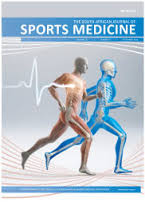The relationship between ankle landing kinematics, isokinetic strength, muscle activity, and the prevalence of lower extremity injuries in university-level netball players during a single season
DOI:
https://doi.org/10.17159/2078-516X/2024/v36i1a16918Abstract
Background: Safe landing in netball is fundamental. Research on the biomechanics of multidirectional landings is lacking, especially among netball players. Furthermore, few studies reporting the associations between ankle kinematics, isokinetic ankle muscle strength, muscle activities, and injury prevalence in South African netball have been undertaken.
Objectives: To determine the relationships between ankle kinematics, kinetics, isokinetic strength, and muscle activity during jump-landing tasks, as well as the prevalence of lower extremity injuries in university-level netball players during a single season.
Methods: This cross-sectional repeated-measure study consisted of ten university-level female netball players. The injury prevalence data was collected during the 2022 netball season. The ankle muscle activity, kinematic, and kinetic data were collected during multidirectional single-leg landing and muscle strength was collected from plantar- and dorsiflexion trials.
Results: Netball players' ankle strength was generally below average. There was evidence of negative correlations between the ankle range of motion (ROM), isokinetic strength, and muscle activity amplitudes. A lack of evidence prevented the conclusion that lower extremity dominance predisposed players to injury, and that any specific body part was more likely to be injured among netball players.
Conclusion: Landing forces and muscle activity are direction-dependent, especially for the dominant limb. Lower extremity strength and neuromuscular control (NMC) across multiple jump-landing directions should be an area of focus for female netball players.
Downloads
Downloads
Published
Issue
Section
License
Copyright (c) 2024 South African Journal of Sports Medicine

This work is licensed under a Creative Commons Attribution 4.0 International License.
The South African Journal of Sports Medicine reserves copyright of the material published. The work is licensed under a Creative Commons Attribution 4.0 (CC BY 4.0) International License. Material submitted for publication in the South African Journal of Sports Medicine is accepted provided it has not been published elsewhere. The South African Journal of Sports Medicine does not hold itself responsible for statements made by the authors.
How to Cite
- Abstract 456
- PDF 411






.png)